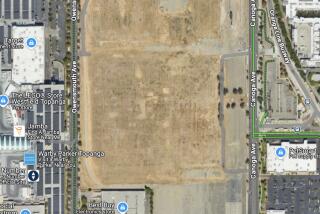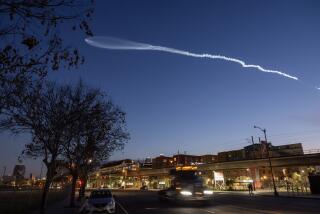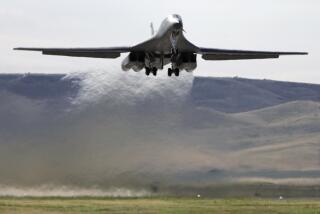Air Force Says Blast Left Little Toxic Gas : Experiments: Rocket fuels are used in a ‘Star Wars’-related ICBM test at Edwards Air Force Base. Initial results show little vapor escaped into air.
- Share via
The Air Force blew up ICBM components in a “Star Wars”-related test Friday at Edwards Air Force Base, sending an orange-gray fireball fed by 2 tons of toxic rocket fuels rising several thousand feet over the Mojave Desert.
An Air Force environmental study before the blast had said a “toxic plume” of unburned fuel vapor would spread over some remote, unoccupied areas of the base, but would do no damage. Air Force officials said after the blast, however, that initial results from air monitoring stations downwind from the explosion showed no significant readings.
“The wind and the weather conditions were perfect. So we went ahead and did it while we had the chance,” said Col. Michael Havey, deputy director of the astronautics lab at the base. “The test was picture-perfect. The countdown went without a hitch.”
The explosion was designed to test the ability of so-called kinetic energy weapons to destroy incoming enemy missiles. The technology, which involves firing projectiles at extreme speeds, is being studied as part of the Strategic Defense Initiative, often called “Star Wars.”
Havey said monitors successfully captured data on the explosion of rocket fuel tanks containing hydrazine and nitrogen tetroxide, similiar to those that would power an intercontinental ballistic missile. But Havey said he could not comment on what the test data showed about a possible weapon.
The test at 10:01 a.m. used 145 pounds of plastic explosive to blow up tanks containing 1,500 pounds of hydrazine and 2,600 pounds of nitrogen tetroxide at a site in the remote northeastern corner of the 300,000-acre base, located in the high desert about 90 miles northeast of downtown Los Angeles.
Another similar test, involving the same two highly hazardous fuels, could be carried out at Edwards as early as November, Havey said. Nitrogen tetroxide is a highly toxic oxidizer that can give off a potentially deadly gas. Hydrazine is a common but also toxic rocket fuel.
In announcing an environmental clearance for the test on Thursday, only one day before it was carried out, the Air Force had said about 50% of the nitrogen tetroxide and 20% of the hydrazine would escape the fireball and disperse downwind.
But Havey said Friday that was a “worst case” estimate and that the actual explosion and resulting fireball appeared to consume most of the fuel. He said the fireball would have carried any remaining fuel vapor high into the atmosphere where it would naturally become inert.
Havey said the Air Force had 23 air monitoring stations downwind from the blast site, at distances from one-quarter mile to 5 miles, all within the base. He said they detected no contaminants at the farthest distances, and “no significant readings” at the closest stations.
The test was originally scheduled for Eglin Air Force Base in Florida, but was shifted to Edwards because of Air Force concerns that it could harm an endangered species of Florida woodpecker.
The Mojave Desert region where Edwards is located also is home to a federally protected endangered species, the desert tortoise, along with the Mojave ground squirrel, which is on the state list of endangered animals. The Air Force said that unlike woodpeckers, which could not be prevented from flying into a test area, tortoises and ground squirrels would be hibernating at this time of year and any that appeared above ground could be shooed away from the blast site before the explosion.
More to Read
Sign up for Essential California
The most important California stories and recommendations in your inbox every morning.
You may occasionally receive promotional content from the Los Angeles Times.










